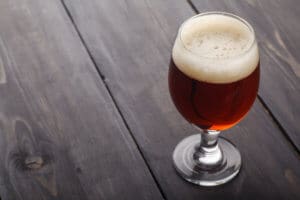Flanders red ale originates from the identically-named portion of northern Belgium. Inhabitants of Flanders speak Flemish, a dialect of dutch, so sometimes this style of beer is called a Flemish red ale. The region has a long history of brewing red and brown ales, but many believe the specific Flanders red ale began with the founding of the Rodenbach Brewery in 1821. It wasn’t the founder himself, but his grandson who learned about Porter-style beer making in the UK and used some of the techniques, like barrel aging, to create a unique new style that put the entire region on the map.
 How is a Flanders red ale produced?
How is a Flanders red ale produced?
To make a Flanders Red Ale, the brewer will usually begin with a darker base malt and some caramel malts to create a beverage with a ruby, brownish hue. Another interesting ingredient in the grist is a good deal of corn or maize. It’s the corn that gives the beverage a dry finish. When it gets to hops, however, there’s not much focus at all and typically common European hops are used. This is definitely a beer where hops take a back seat. The critical part of beermaking that contributes to the Flanders red ale tradition is the fermentation process. While breweries all have their own proprietary tweaks to the process, there are some commonalities between most of them. The primary fermentation begins in stainless steel with typical ale yeast. That may be the end of the road for some beer, and it will be labeled as “young beer.” Other beer goes on to a second fermentation in large oak barrels (foeders) for eight to 24 months or even more. Next, the beer maker will blend the beer from the foeders with the young beer to produce beers with different flavors. If the percentage of young beer is greater than the foeder-fermented beer, it will have a softer, less acidic flavor. The opposite is true if the percentage of foeder-fermented beer is greater.
What does a Flanders Red Ale taste like?
A Flanders red ale has a deep flavor experience. Most will have a complex fruit flavor, such as black cherries, oranges, or red currents, that combine with vanilla or chocolate notes gained during the oak aging process. Lactobacillus and Brettanomyces used during fermentation will give it a bit of sourness to pull it all together. Some people feel there is a wine-like taste to the beer. Typically, the beer will be served in a tulip glass.
Visit The Growler Guys to experience new styles of beer.
Explore the growing variety of beers in one taproom, The Growler Guys. Each location carries the best local varieties, from the palest ales to the darkest stouts, along with ciders and kombucha. Our friendly staff is happy to walk you through the characteristics of every style to help you discover your personal favorites. Take home the beers you love best in a growler to share with family and friends. View our online tap list to learn about the available selections at a location near you.

 How is a Flanders red ale produced?
How is a Flanders red ale produced?
Reader Interactions